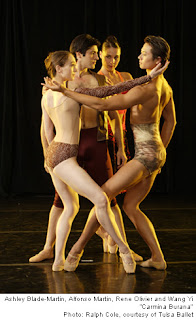... he died on March 29, 1982 at the age of 86.
-----
A Bavarian, Carl Orff was born in Munich on July 10, 1895. He started studying the piano at the age of five, and he also took organ and cello lessons. However, he was more interested in composing original music than in studying to be a performer. Orff wrote and staged puppet shows for his family, composing music for piano, violin, zither, and glockenspiel to accompany them. He had a short story published in a children's magazine in 1905.  By the time he was a teenager, Orff was writing songs, although he had not studied harmony or composition. Orff wrote his own texts and he learned the art of composing, by studying classical masterworks on his own.
In 1911, at age 16, some of Orff's music was published. Many of his youthful works were songs, often settings of German poetry with hints of what would become Orff's distinctive musical language.
By the time he was a teenager, Orff was writing songs, although he had not studied harmony or composition. Orff wrote his own texts and he learned the art of composing, by studying classical masterworks on his own.
In 1911, at age 16, some of Orff's music was published. Many of his youthful works were songs, often settings of German poetry with hints of what would become Orff's distinctive musical language.
In 1911/1912, Orff wrote Also sprach Zarathustra ("Thus Spoke Zarathustra"), Op. 14, a large work for baritone voice, three choruses and orchestra, based on a passage from Friedrich Nietzsche's philosophical novel. The following year, he composed an opera, Gisei, das Opfer ("Gisei, the Sacrifice.") Influenced by the French Impressionist composer Claude Debussy, he began to use colorful, unusual combinations of instruments in his orchestration.
Orff studied at the Munich Academy of Music until 1914. He then served in the German Army during World War I, when he was severely injured and nearly killed. Afterwards, he held various positions at opera houses in Mannheim and Darmstadt, later returning to Munich to pursue his music studies.
In the mid-1920s, Orff began to formulate a concept he called "elementare Musik," or elemental music, which was based on the unity of the arts symbolized by the ancient Greek Muses and involved tone, dance, poetry, image, design, and theatrical gesture. He also began adapting musical works of earlier eras for contemporary theatrical presentation, including Claudio Monteverdi's opera L'Orfeo.
In 1924 Dorothee Günther and Orff founded the Günther School for gymnastics, music, and dance in Munich. Orff was there from 1925 until the end of his life. There he developed his theories of music education. Orff also edited 17th-century operas. However, these various activities brought Orff very little money.
Carmina Burana
Orff composed Carmina Burana, a “scenic cantata” in 1935-36 It is based on 24 of the poems found in the medieval collection Carmina Burana. Its full Latin title is Carmina Burana: Cantiones profanæ cantoribus et choris cantandæ comitantibus instrumentis atque imaginibus magicis ("Songs of Beuern: Secular songs for singers and choruses to be sung together with instruments and magic images.")
 |
| "Carmina Burana" Cincinnati Ballet - Choreographer Mauricio Wainrot |
The original text dated mostly from the 11th or 12th century, including some from the 13th century. Michel Hofmann, then a young law student and Latin and Greek enthusiast, assisted Orff in the selection and organization of 24 of these poems into a libretto, mostly in Latin verse, with a small amount of Middle High German and Old Provençal.
The selection covers a wide range of topics, as familiar in the 13th century as they are in the 21st century: the fickleness of fortune and wealth, the ephemeral nature of life, the joy of the return of Spring, and the pleasures and perils of drinking, gluttony, gambling and lust.
Carmina Burana was first staged in Frankfurt by the Frankfurt Opera on June 8, 1937. The Nazi regime was at first nervous about the erotic tone of some of the poems, but eventually embraced the piece. It became the most famous piece of music composed in Germany at the time. The popularity of the work continued to rise after the war, and by the 1960s Carmina Burana was well established as part of the international classic repertoire.
Orff's relationship with German fascism and the Nazi Party has been a matter of considerable debate and analysis. Given Orff's previous lack of commercial success, the monetary factor of Carmina Burana's acclaim was significant to him.
But the composition, with its unfamiliar rhythms, was also denounced with racist taunts.
Following World War II, during his denazification process in Bad Homburg, Orff claimed that he had helped establish the "White Rose" resistance movement in Germany. There was no evidence for this other than his own word, and other sources dispute his claim.
Most of Orff's later works – Antigonae, Oedipus der Tyrann, Prometheus, and De temporum fine comoedia – were based on texts or topics from antiquity. Live performances of them have been few.
####






No comments:
Post a Comment
PLEASE LEAVE A COMMENT